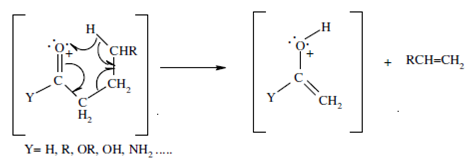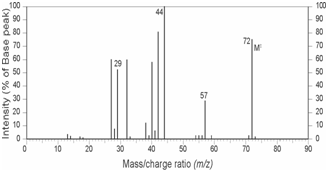Fragmentation due to Intramolecular Rearrangement: McLafferty Rearrangement
Sometimes the origin of the fragments observed in a mass spectrum cannot be attributed to a formal cleavage; instead it includes some kind of an intramolecular rearrangement. Like rearrangements often explain the existence of prominent characteristic peaks in the mass spectrum and are therefore very useful in structure elucidation. One of the most important rearrangements, called McLafferty rearrangement is observed in the molecules containing a carbonyl group having abstractable hydrogen at a position γ to the carbonyl group.

As an instance, let us take the mass spectrum of butanal (CH3CH2CH2CHO) given in Figure.

Figure: Mass spectrum of butanal
The prominent peaks in the spectrum are at m/z 72, 57, 44 and 29. Of these, the peak at m/z 72 is the molecular ion peak and the ones at 57 (M - 15) and 29 (M - 43) can be explained in terms of methyl and propyl radicals respectively. The peak observed at m/ z 44 (M - 28) can be explained in terms of McLafferty rearrangement as shown below.
